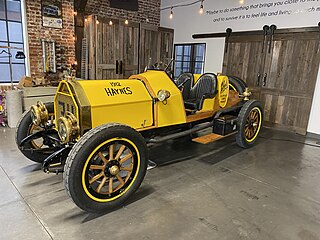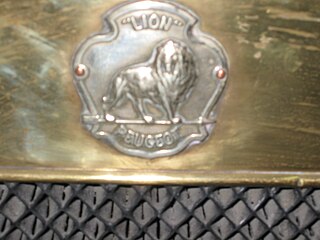
McLaughlin Motor Car Company Limited was a Canadian manufacturer of automobiles headquartered in Oshawa, Ontario. Founded by Robert McLaughlin, it once was the largest carriage manufacturing factory in the British Empire.

Charles Williams Nash was an American automobile entrepreneur who served as an executive in the automotive industry. He played a significant role in building up General Motors as its fifth president. In 1916, he bought Thomas B. Jeffery Company, makers of the popular Rambler automobile, and renamed it Nash Motors. The resulting firm played an independent role in an automobile industry increasingly dominated by the Big Three: General Motors, Ford, and Chrysler.

Louis-Joseph Chevrolet was an American racing driver, mechanic and entrepreneur who co-founded the Chevrolet Motor Car Company in 1911.

William Crapo Durant was a leading pioneer of the United States automobile industry, founder of General Motors and co-founder of Chevrolet. He created a system in which a company held multiple marques – each seemingly independent, with different automobile lines – bound under a unified corporate holding company. Durant founded General Motors and co-founded Chevrolet with Louis Chevrolet. He also founded Frigidaire.

Charles Edgar Duryea was an American engineer. He was the engineer of the first working American gasoline-powered car and co-founder of Duryea Motor Wagon Company. He was born near Canton, Illinois, a son of George Washington Duryea and Louisa Melvina Turner, and died in Philadelphia, Pennsylvania, but spent most of his life working in Springfield, Massachusetts. It was in Springfield that Charles and his brother, Frank, produced and road-tested America’s first gasoline-powered car.

Baker Motor Vehicle Company was an American manufacturer of Brass Era electric automobiles in Cleveland, Ohio, from 1899 to 1914. It was founded by Walter C. Baker.

The Jeffery brand of automobiles were manufactured by the Thomas B. Jeffery Company in Kenosha, Wisconsin.
The National Motor Vehicle Company was an American manufacturer of automobiles in Indianapolis, Indiana, between 1900 and 1924. One of its presidents, Arthur C. Newby, was also one of the investors who created the Indianapolis Motor Speedway.

Mercer was an American automobile manufacturer from 1909 until 1925. It was notable for its high-performance cars, especially the Type 35 Raceabout.

Charles Cleveland Merz was an American racing driver, military officer, engineering entrepreneur, and racing official. Active in the early years of the Indianapolis 500, he later became Chief Steward of the Memorial Day Classic.

Robert R. Burman was an American racing driver. He was an open-wheel pioneer, setting numerous speed records in the early 1900s. He participated in many historic races and was one of the drivers to compete in the first edition of the Indianapolis 500 in 1911.

The Haynes Automobile Company also known by its badge as “Americas First Car” was an early American automobile manufacturing company that produced automobiles in Kokomo, Indiana, from 1905 to 1924. The company was formerly known as the Haynes-Apperson company, and produced automobiles under that name from 1894 to 1905. Co-founder Elwood Haynes changed the name of the company to the Haynes Automobile Co after fellow co-founders Elmer and Edgar Apperson left to form the Apperson Brothers Automobile Company in 1901. The Haynes company was declared bankrupt in 1924 and went out of business in 1925.

The Cutting was an American automobile manufactured in Jackson, Michigan by the Clark-Carter Automobile Company from 1909 to 1912, and the Cutting Motor Car Company in 1913. It was made in the same factory as previously produced the C.V.I. make. The Cutting was engineered by Charles Cutting, using engines from Milwaukee, Model, and Wisconsin ranging from 30 to 60 hp. Prices ranged from US$1,200 to $1,500. In 1912 the company claimed to have the highest power-to-price ratio of any car at or above the $1,200 price.

Scripps-Booth was a United States automobile marque based in Detroit, Michigan. Established by James Scripps Booth in 1913, Scripps-Booth Company produced motor vehicles and was later acquired by General Motors, becoming a division of it, until the brand was discontinued in 1923.

The Keeton was a brass era automobile built in Detroit, Michigan from 1912 to 1914 by the Keeton Motor Car Company.

Daniels Motor Company was a pioneer brass era American automobile company, founded in 1915 by George E. Daniels with Neff E. Parish. George Daniels was a known lawyer, engineer, and mechanic. He was considered the best motorcar designer in the United States. Neff Parish had his own automobile parts and framing manufacturing company. Neff was the creator of the time's highest-grade heat-treated alloy steel frames, respected in the steel industry. Daniels Motor Company produced 1,500 high-quality automobiles between 1916 and 1924, branding themselves as “the distinguished car with just a little more power than you will ever need”, and “The aristocrat of American cars”.

Ernest "Ernie" Moross was an early-twentieth-century press agent and promoter specializing in American motorsports. He was a longtime associate of the first American auto racing superstar, Barney Oldfield. Moross also obtained distinction as the first Contest Director for the Indianapolis Motor Speedway. He left the Speedway in 1910 to campaign the Fiat racing team.

Lion-Peugeot is a formerly independent French auto-maker. It is the name under which in 1906 Robert Peugeot and his two brothers, independently of the established Peugeot car business, began to produce automobiles at Beaulieu near Valentigney.

The Buick 60 Special is an early American racing car, two of which were built by Buick in 1910. It is one of the first US-built cars with just a single seat for the driver that was centrally located. The car is nicknamed the Buick Bug.

















